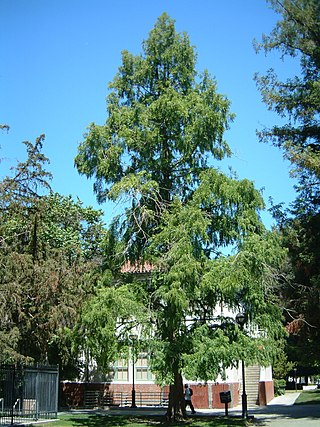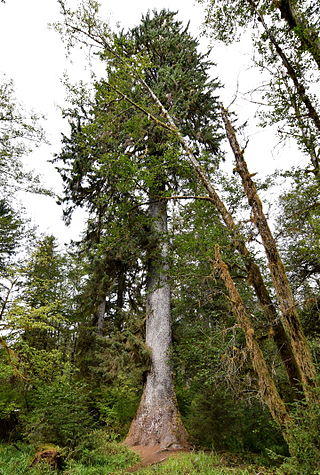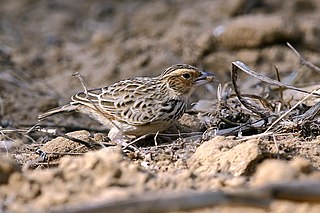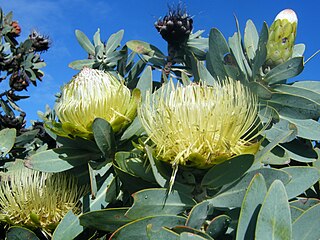
Metasequoia glyptostroboides, the dawn redwood, is a fast-growing, endangered deciduous conifer. It is the sole living species of the genus Metasequoia, one of three genera in the subfamily Sequoioideae of the family Cupressaceae. It now survives in the wild only in wet lower slopes and montane river and stream valleys in the border region of Hubei and Hunan provinces and Chongqing municipality in south-central China, notably in Lichuan county in Hubei. Although the shortest of the redwoods, it can grow to 167 ft (51 m) in height.

The Bengal bush lark or Bengal lark is a species of lark in the family Alaudidae found in southern Asia.

Picea sitchensis, the Sitka spruce, is a large, coniferous, evergreen tree growing to just over 100 meters (330 ft) tall, with a trunk diameter at breast height that can exceed 5 m (16 ft). It is by far the largest species of spruce and the fifth-largest conifer in the world, and the third-tallest conifer species. The Sitka spruce is one of only four species documented to exceed 100 m (300 ft) in height. Its name is derived from the community of Sitka in southeast Alaska, where it is prevalent. Its range hugs the western coast of Canada and the US and continues south into northern California.

Camellia sinensis is a species of evergreen shrub or small tree in the flowering plant family Theaceae. Its leaves, leaf buds, and stems can be used to produce tea. Common names include tea plant, tea shrub, and tea tree.

The blue spruce, also commonly known as green spruce, Colorado spruce, or Colorado blue spruce, is a species of spruce tree native to North America in Arizona, Colorado, Idaho, New Mexico, Utah and Wyoming. It is noted for its blue-green colored needles, and has therefore been used as an ornamental tree in many places far beyond its native range.

Hesperocyparis bakeri, previously known Cupressus bakeri, with the common names Baker cypress, Modoc cypress, or Siskiyou cypress, is a rare species of western cypress tree endemic to a small area across far northern California and extreme southwestern Oregon, in the western United States.

Larix lyallii, the subalpine larch, or simply alpine larch, is a deciduous, coniferous tree native to northwestern North America. It lives at high altitudes, from 1,500 to 2,900 meters, in the Rocky Mountains of Idaho, Montana, British Columbia, and Alberta. There is a disjunct population in the Cascade Range of Washington.

Jerdon's bush lark or Jerdon's lark is a species of lark in the family Alaudidae found in south Asia. This was formerly considered as a subspecies of Mirafra assamica and termed as the Madras bushlark. Two other species in the complex include Mirafra marionae and Mirafra microptera. Jerdon's bush lark is typically very pale on the underside

Lemurophoenix halleuxii is a species of palm tree, the only species in the genus Lemurophoenix. It is found only in Madagascar. It is threatened by habitat loss and overcollection. There are perhaps 300 mature individuals remaining in the wild.

The Indochinese bush lark or Indochinese lark is a species of lark in the family Alaudidae found in southeast Asia.

The Burmese bush lark or Burmese lark, is a species of lark in the family Alaudidae found in Southeast Asia.
Neohopea isoptera is a species of flowering plant in the family Dipterocarpaceae. It is the sole species in genus Neohopea. It is a tree endemic to Borneo. It is native to lowland mixed dipterocarp forest up to 500 meters elevation, where it is a canopy tree growing up to 60 meters tall.
Anthoshorea agami, synonym Shorea agami, is a species of plant in the family Dipterocarpaceae. The species is named after J. Agama a one time forest officier in the Sabah Forestry Department.

Arctostaphylos columbiana is a species of manzanita known by the common name hairy manzanita. It is native to the coast of western North America from northern California to southwestern British Columbia. This large manzanita is a shrub or small tree, usually 1–5 meters tall. It is erect with hairy branches. The leaves are oval-shaped and are usually 2-6 centimeters long and 2-3 wide, pale bluish green, fuzzy on both surfaces, occasionally glandular. The small, white, urn-shaped flowers are borne in bunched inflorescences. The fruit is a red drupe about a centimeter in diameter. The seed requires either fire or consumption by animals in order for germination to occur. This manzanita grows in open, rocky areas. It is sometimes grown as a garden ornamental. Hybrids with Arctostaphylos uva-ursi commonly occur where the two parent species grow in proximity.

Ilex mitis is a tall, dense, evergreen tree that is indigenous to Sub-Saharan Africa and Madagascar. It makes an excellent fast-growing hedge for gardens - growing tall, straight and dense.

Protea nitida, commonly called wagon tree, waboom or blousuikerbos, is a large, slow-growing Protea endemic to South Africa. It is one of the few Protea species that grows into trees, and the only one that has usable timber.
Cinnamosma macrocarpa is a species of flowering plant in the family Canellaceae. It is endemic to Madagascar.

Camellia taliensis is a small species of evergreen shrub whose leaves and leaf buds are used to produce tea.
Canarium elegans is a species of tree in the family Burseraceae. It is native to Madagascar.
Alsophila solomonensis is a species in the family Cyatheaceae, commonly called tree ferns.















